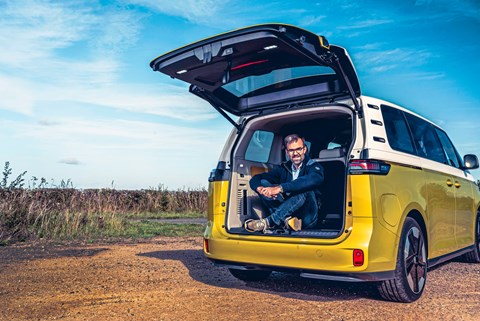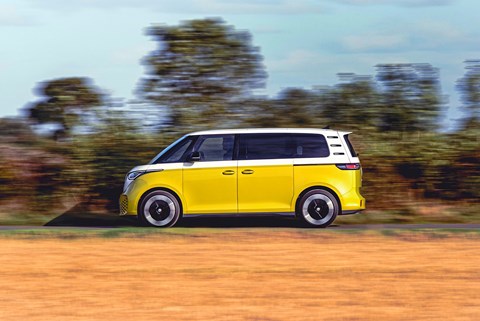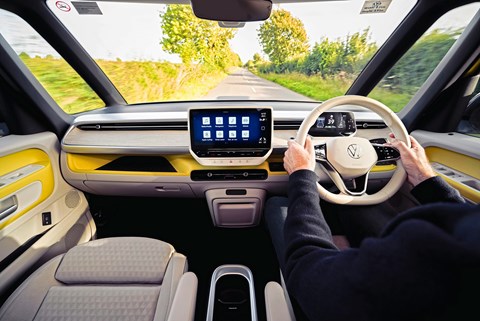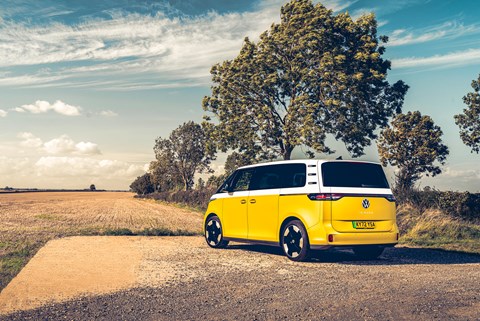► Our final report on life with an ID.Buzz
► Until the ID.7 turned up, this was the best ID
► Read month 5 here
Until the arrival of the polished ID. 7, I would tell anyone who’d listen that the ID. Buzz was the best electric Volkswagen on sale. It has a cohesive polish that just works: a roomy package, family-friendly features galore and a slick drive all wrapped up in a deliciously cool package. What’s not to like?
Now I’ve spent six months living with one, I’m still feeling overwhelmingly positive. I’ll miss its easy charm, those head-turning looks and the jump-in-and-go ease of use. But it’s not all smelling of roses. And I’ve acquired the nagging feeling that it’s less a bus for everyday folk than I’d hoped; too much of its appeal is superficial.
There’s the price, for starters. Yes, all electric cars are expensive, but the Buzz certainly has lofty positioning with an RRP starting at £59k. Third-party lease deals can dip towards £350 a month and at the time of writing Volkswagen has just launched a £5500 deposit contribution towards PCP deals, a year’s free insurance and three free services, which is more tempting value.

A cavernous 1121-litre boot with all five seats in place won me over initially and made mincemeat of tip runs and trips with the dog, but I came to miss the clever van trickery that used to be part of the package with VWs: there are no swivelling captain’s seats up front, no removable rear pews and none of the interchangeability that’s won countless hearts and minds among generations of California, Multivan and Transporter drivers.
It feels like the electric ID branch hasn’t quite been introduced to the VW commercial-vehicle team across the corridor in R&D. It’s surely only a matter of time before the two start sharing their knowledge more effectively, perhaps beginning with this summer’s arrival of a seven-seat long-wheelbase ID. Buzz. Our car is really just a giant five-seat hatchback.
I’m put in mind of a phrase from the digital sphere: MVP. Rather than the sporting world’s ‘most valuable player’, this stands for ‘minimum viable product’ – shorthand for software development that is pared back and just enough for a basic, quick launch. It tends to mean shortcuts and missing features rushed to market for testing before evolving quickly to become a fully formed product.

I think this sums up the VW approach to the whole ID family, begat as it was in the rush to save face after Dieselgate and accelerate Wolfsburg’s EV conversion therapy.
Once you accept this, the rest of the ID. Buzz package works well. The sliding side doors make rear access a cinch, although we should point out our nearside door ended up creaking a fair bit when on the move. It was the only thing to spoil the hushed refinement on a long journey, where the high-mounted seats proved comfy, the radar cruise control relaxing and road noise generally well suppressed.
Nothing fell off or went wrong in our half-year, 11,000-mile test and nor did we need to visit a dealer (service intervals fall every two years, with no mileage limit). It feels well built in that Volkswagen way and familiarity hasn’t blunted the appeal of the smart retro style.
This is one very cool bus that, at least visually, slots seamlessly into the bloodline of fun-loving Vee Dubs with attitude. I cannot stress enough how many heads it turns and the general love displayed towards the Buzz, especially in our fizzy Lime Yellow and Candy White.

It’s a big car at 4.7 metres long and weighs in at 2.5 tonnes, so we should not be surprised that its consumption of electricity surged ahead of the officially claimed 2.9 miles per kWh: we averaged 2.4 miles per kWh, but it’s worth pointing out that I do more cross-country driving than pootling around town.
With the 77kWh lithium-ion battery, that meant we had a realistic range of 185 miles. That was annoyingly not quite enough for me to drive from home to Heathrow and back, so I became familiar with parts of Britain’s high-speed charger network. Volkswagen claims a 170kW peak charging rate but we witnessed 185kW at one punchy Ionity location.
The Buzz has a becalming effect behind the wheel. I enjoyed the feelgood vibes and always emerged from a drive refreshed and relaxed. Perhaps it was the raised driving position, which provides an easy view out above other cars. But the smooth drivetrain, jump-in-and-select-D ease of use and hushed refinement all played their part.
Performance is best described as ‘leisurely’ or ‘adequate’. There are no electric slingshot thrills here, and nor should there be as far as I’m concerned. Perhaps the upcoming twin-motor GTX version will provide a little more shove, but performance from the 150kW electric motor driving the rear wheels (equivalent to 201bhp) always felt well judged for a vehicle of this ilk. I’m not sure I want more than 90mph flat-out or a 0-62mph sprint in 10.2sec.

Jobs for VW to include in the facelift? Upgrade the rushed infotainment system, obviously. Keep working on powertrain efficiency to push that usable range past 200 miles. And keep chipping away at the price.
Perhaps most importantly, we recommend introducing the ID team to the commercials crew to incorporate more of VW’s peerless van knowledge and features. With an extra dose of versatility, this family wagon really would be Buzzing.
Read month 5
Read month 4
Read month 3
Read month 2
Read month 1
Logbook: VW ID.Buzz
Price £61,915 (£69,265 as tested)
Performance 77kWh battery, e-motor, 201bhp, 10.2sec 0-62mph, 90mph
Efficiency 2.9 miles per kWh (official), 2.4 miles per kWh (tested), 0g/km CO2
Range 255 miles (official), 185 miles (tested)
Energy cost 9.9p per mile
Miles this month 1509
Total miles 10,864
Count the cost
Price new £69,265
Part exchange £43,077
Cost per mile 10.4p
Cost per mile including depreciation £2.47